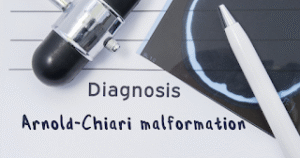Chiari Malformation Awareness Month

Chiari Malformation Awareness Month |
What is Chiari Malformation?
Chiari malformation is a structural condition where brain tissue extends into the spinal canal. This occurs when part of the skull is abnormally small or misshapen, pressing on the brain and forcing it downward. There are different types of Chiari malformation:
- Chiari Malformation Type I: The most common type, where the cerebellar tonsils herniate into the spinal canal without involving the spinal cord.
- Chiari Malformation Type II (Arnold-Chiari Malformation): Usually associated with spina bifida and involves the descent of the cerebellum and brainstem.
- Chiari Malformation Type III: A rarer and more severe type where part of the cerebellum or brainstem protrudes outside the skull.
- Chiari Malformation Type IV: Characterized by the underdevelopment of the cerebellum.
Causes and Risk Factors
The exact causes of Chiari malformation are not fully understood, but genetic and environmental factors are believed to play a role. The condition can be congenital, present at birth, or acquired, developing later in life due to injuries or infections affecting the spine or brain.
Symptoms and Diagnosis
Symptoms of Chiari malformation vary depending on the severity and type of the condition. Some individuals may be asymptomatic, while others experience debilitating symptoms. Common symptoms include:
- Headaches, especially after coughing, sneezing, or straining
- Neck pain
- Balance and coordination problems
- Dizziness and vertigo
- Vision problems
- Difficulty swallowing
- Weakness or numbness in the arms and legs
Diagnosis of Chiari malformation typically involves imaging tests, such as magnetic resonance imaging (MRI), which allows visualization of the brain and spinal canal structures.
Treatment and Management
Treatment for Chiari malformation depends on the severity of the symptoms and the type of condition. In mild cases, regular monitoring and symptom management may be sufficient. For more severe cases, surgery may be necessary to relieve pressure on the brain and spinal cord. The most common type of surgery is posterior fossa decompression, which involves removing a small portion of the bone at the back of the skull to create more space for the brain.
The Importance of Awareness
Chiari Malformation Awareness Month is crucial for increasing the visibility of this rare condition. Many patients face delayed or incorrect diagnoses due to a lack of knowledge about Chiari malformation among healthcare professionals and the general public. Awareness is key to promoting early diagnosis and more effective treatments, as well as supporting research to better understand the condition.
Awareness Color
The official color associated with Chiari Malformation Awareness Month is purple. This color symbolizes the fight against the condition and represents solidarity and support for those affected. Throughout September, it is common to see landmarks illuminated in purple, awareness events, and walks where participants wear purple clothing or accessories. Purple serves as a powerful visual reminder, uniting the community and increasing the visibility of the cause. It also symbolizes hope and perseverance for patients and their families, inspiring empathy and action toward better understanding and treatment of Chiari malformation.
Support Chiari Malformation Awareness with this purple campaign t-shirt. Featuring the iconic awareness ribbon, this shirt promotes solidarity, hope, and the fight for better treatment. Wear it proudly to raise awareness in September and beyond!
 |
| Chiari Malformation t-shirt |
Major Research and Support Organizations
Several institutions play a crucial role in research, support, and advocacy for Chiari malformation. These organizations are dedicated to raising awareness, providing resources for patients, and supporting research to better understand and treat the condition. Some of the major institutions involved include:
1. Chiari & Syringomyelia Foundation (CSF)
The Chiari & Syringomyelia Foundation is one of the leading organizations dedicated to supporting and researching Chiari malformation and associated syndromes. The foundation provides educational information, patient and family support, and funding for advanced research. They also organize awareness events and campaigns to increase the visibility of the condition.
- Website: chiariandsyringomyelia.org
2. The Chiari Network
The Chiari Network is a nonprofit organization that aims to connect patients, families, and healthcare professionals to share information and experiences about Chiari malformation. The network also supports research and promotes awareness of the condition.
- Website: chiari-network.org
3. The Chiari Malformation Association (CMA)
The Chiari Malformation Association is dedicated to providing support and resources for those affected by Chiari malformation. The association promotes education about the condition, supports research, and offers a community of support for patients and their families.
- Website: chiariassociation.org
4. The National Institute of Neurological Disorders and Stroke (NINDS)
The NINDS is a leading US government research institute focused on neurological disorders, including Chiari malformation. The institute funds research to better understand the condition and develop new treatments.
- Website: ninds.nih.gov
5. The American Association of Neurological Surgeons (AANS)
The AANS is a professional organization representing neurosurgeons and other healthcare professionals specializing in neurological disorders, including Chiari malformation. The association provides patient and physician information and supports research and education in neurosurgery.
- Website: aans.org
These institutions play a vital role in promoting awareness, supporting patients, and advancing research on Chiari malformation. They provide valuable resources and help unite the community to face the challenges associated with this condition.
Conclusion
Chiari malformation is a complex and often misunderstood condition. Chiari Malformation Awareness Month provides an opportunity to educate the public, support those affected, and promote research and development of treatments. Through awareness and continued support, it is possible to improve the quality of life for those living with this condition and move towards a future with better treatment and care options.
